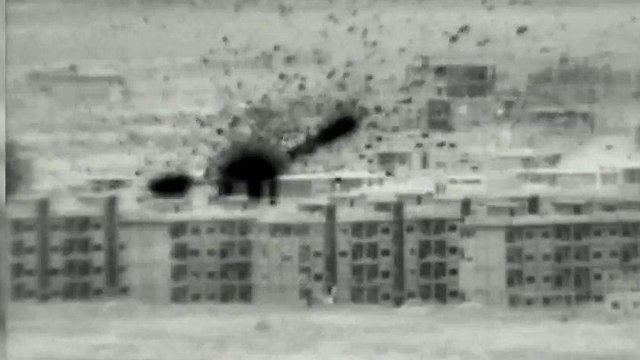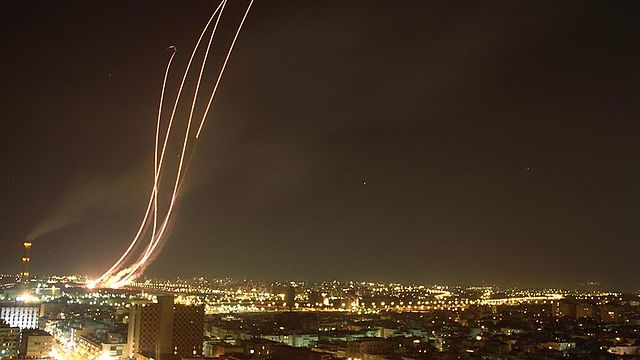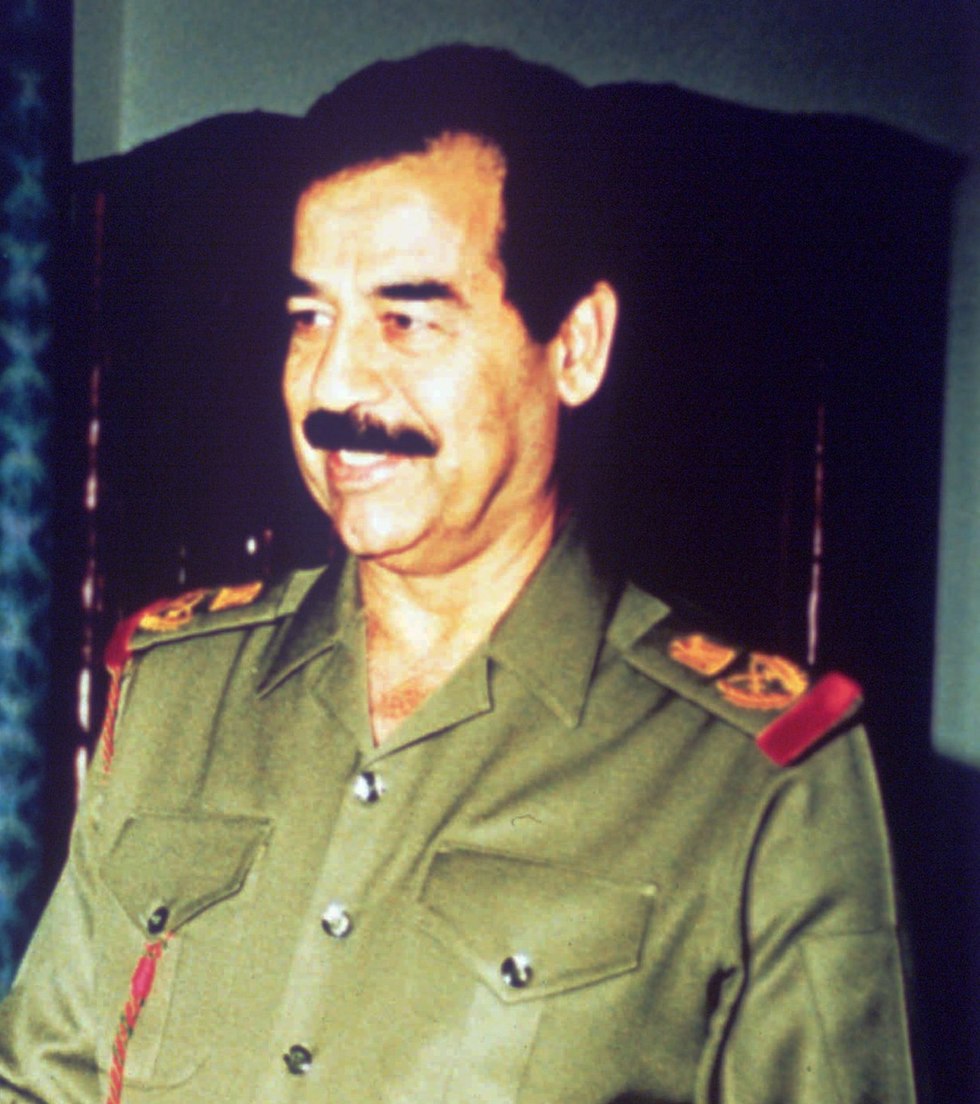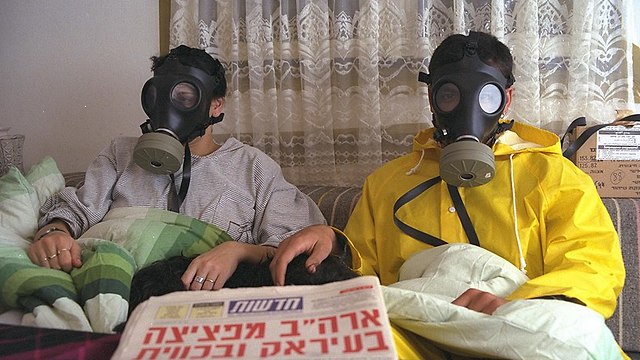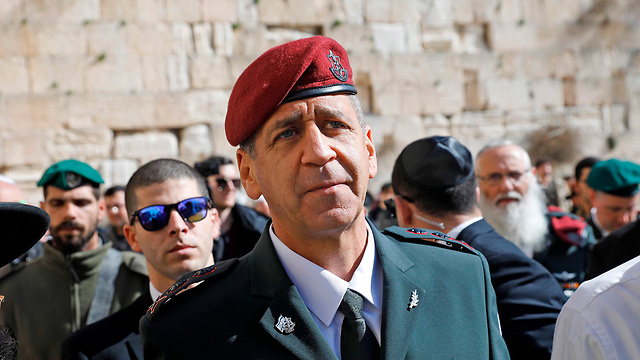

When Israel prepared to conquer Baghdad
During the First Gulf War, Israeli political and military leaders found themselves on a steep learning curve as the country was pounded by Saddam Hussein's Scuds; the lessons from that experience — and the demands of the Americans —still resonate, in particular regarding a devious Iranian plan to strike the Jewish state from Iraq.
It is a cunning Iranian move: missile fire from Iraq would not give Israel just cause to attack Syria or Lebanon, and it would put the Jewish state in a dilemma. Furthermore, an attack on Iraq requires coordination with the US, who has already informed Israel that any military action it takes in Iraq would endanger the lives of Americans protecting the Baghdad regime. It would also require coordination with neighboring countries such as Jordan and Saudi Arabia to allow the Israel Air Force warplanes to fly in their airspace. It's obvious these countries will not openly cooperate with Israel in attacking a neighboring Arab nation.
This has happened over the past year, and caused the IDF to raise its level of alert. The Iranians didn't send the missiles as a mere threat, they also intend to use them for a strike in retaliation or for deterrence.
On February 10, 2018, the IAF attacked the T-4 Air Base in northern Syria, destroying a command and control trailer for an Iranian drone after it infiltrated Israel. During that same incident, an IAF F-16 fighter jet was downed over Israeli territory by a Syrian anti-aircraft missile. Iranian military personnel were killed in the Israeli strike, and Tehran prepared to retaliate through the Shiite militias it has at its beck and call. It seems that it was only due to heavy diplomatic pressure that the missile threat from Iraq was lifted. Instead, the Iranians on May 10 launched more than 20 rockets towards the Israeli Golan Heights, which didn't cause any damage or create a new balance of deterrence. On the contrary, they only gave Israel cause to strike the Iranians again where it's convenient for the IDF — in Syria.
Gadi Eisenkot's General Staff didn't have to deal with long-range missile fire—from Lebanon, Syria, Iraq or Iran—to a large extent thanks to a smart policy of ambiguity that allowed Israel "plausible deniability," and didn't force the enemy to respond to strikes for which Israel had not claimed responsibility.
The recent decision to tear down the veil of ambiguity surrounding Israel's military operations in Syria leaves the General Staff, now under the command of new IDF Chief of Staff Aviv Kochavi, with the need to preserve and enhance Israeli deterrence in other ways. Beyond the creativity and daring that have characterized Kochavi's military career so far, this will require him for the first time to display political capabilities. To allow the IDF the freedom of operations in Syria, with a window of opportunity that is closing as the civil war in the country draws to an end, he will have to win support from the prime minister and every single member of the security cabinet.
The Iranian attempt at entrenchment in Syria has been halted for now, but the final word has not yet been uttered. An Iranian attack against Israel from Iraqi soil is still a realistic scenario. Is the IDF prepared to deal with a new front from Iraq? Will the government withstand American pressure to leave the work of ridding Iraq of the Iranians to someone else? Will Israel's Arab friends cooperate with it? Will Israel choose not to respond to missiles from Iraq or Iran into its territory, despite the blow it would deliver to its deterrence? Or alternatively, will the Israeli government allow the military to take heavy punitive action, including damaging civilian infrastructure, to make it clear to the entire Middle East that Israeli citizens are not free play?
A different General Staff, no less talented, had to contend with the same questions in the 1990s, and couldn't deliver answers.
The sites in western Iraq where the Iranians might deploy missiles, are in almost the same area from which the long-range "Al Hussein" Scud missiles were launched at Israel during the First Gulf War. On January 18, 1991, almost precisely 28 years ago to the day, eight Al Hussein missiles were launched for the first time from western Iraq toward population centers in central Israel and the Haifa area. Israel didn't respond that day, and remained diplomatically paralyzed, with undeveloped military plans, until the end of the US-led coalition's Operation Desert Storm on February 28.
I
n total, some 40 missiles were fired from Iraq, most of them at Dan region. Israel didn't respond, and it is paying the price in psychological deterrence price to this very day. The enemy learned Israel's Achilles' heel. Even Hamas dares to launch rockets at Tel Aviv and still remains standing. The Gulf War created the "ethos of restraint," which in the years that have passed has become a doctrine at which Israel. The historical memory is that Israel held back and didn't attack due to heavy American pressure. But this is only half the truth.
The fear: Attack on Dimona
The beginning was actually promising. As early as April 1990, four months before the Iraqi invasion of Kuwait and nine months before the first missile was fired at Israel, Israeli intelligence uncovered seven stationary launchers stationed in western Iraq. In July, initial preparations began for an operation to strike this apparatus, and then a series of discussions and preparations began for special ops—both aerial and ground—of different scales. But this saga was filled with zig-zagging. There wasn't a clear worldview, no plan reached a point at which it had reasonable odds of success, and the diplomatic conditions had not yet ripened. Israel was running on the spot.
Three weeks after the Iraqi invasion, on August 21, 1990, the IDF General Staff held war games to examine the different ways to deal with the threats from Iraq. By this point, the IDF was already on high alert in light of assessments that an all-out regional conflict would include Israel as well. At the conclusion of the war games, there was talk of possible missile fire or a potential Iraqi airstrike on strategic targets, such as the Dimona nculear reactor and major population centers. There was also the assessment that the Iraqis had the ability to use chemical weapons against one of those strategic targets, like Dimona.
Most of the speakers at the meeting—head by then-IDF chief Dan Shomron, his deputy Ehud Barak, the head of the Military Intelligence Directorate Amnon Lipkin-Shahak, and Air Force Commander Avihu Ben-Nun—believed that Iraq would try to provoke Israel in order to draw it into war and dismantle the American coalition with the Arab world. Therefore, they predicted there would be American pressure on Israel not to take action. Most of those present agreed that there was room for Israeli restraint regarding the timing, scope and nature of a potential response, and they all agreed any move should be coordinated with the Americans.
Shomron's General Staff—just like Gabi Ashkenazi's General Staff, which dealt with the possibility of a strike on Iran's nuclear project 20 years later—preferred to have the Americans solve the problem for Israel. But they weren't confident the Americans would do the job in a satisfactory manner, so they all agreed that if Iraq launched missiles at major Israeli population centers, Israel would have no choice but to respond.
Then GOC Northern Command, Maj. Gen. Yossi Peled argued that Israel had to respond either way, even if missiles were only launched at military targets, otherwise it would undermine Israel's deterrence against the threat of indirect fire in the future. Lipkin-Shahak addressed the possibility of friction with Jordan in the case of Israeli airstrikes on Baghdad, and recommended Israel "examine other painful responses, such as hitting Iraqi shipping."
The IDF chief assessed that the Israeli military did not have the ability to destroy the Iraqi Air Force, and it also did not have the ability to completely prevent or stop missile fire at Israel. Therefore, he said, the top priority for the military would be how to restore Israeli deterrence, and not how to remove the threat. In other words, deter Iraq from further missile fire.
"If Israeli population centers are hit," the IDF chief said at the conclusion of the war games, "Israel will pound government and strategic sites in Baghdad and military targets in western Iraq, to send the Iraqis an unequivocal message: if the missile fire doesn't stop, we will hit population centers in Baghdad."
The war games exposed the fact the IDF did not have a concrete view on when to use force or indeed have an operational plan in the face of the threat of missile fire toward Israel from western Iraq. At the time, the IDF was prepared to fight off two Iraqi units that were supposed to join an eastern front against Israel—one from the direction of Syria and the other from the direction of Jordan. But it didn't have an effective plan to deal with missiles or long-range rockets. The only plan the military had when the crisis erupted was meant to deal with Syrian chemical weapons, and the IDF top brass were now trying to adjust it for the existing conditions in western Iraq.
But that plan was not ready either. From the moment it was presented in late 1989 and until the end of the First Gulf War, it remained unclear who would command this operation, which combined the Israel Air Force, the Ground Forces and the Intelligence Directorate. A bitter argument was waged between the Air Force and special ops HQ (which at the time was under the command Maj. Gen. Doron Rubin). The decisions made by the IDF chief, his deputy, and the head of the Operations Division didn't help settle the dispute. Conversely, a similar dispute is currently ongoing between the Depth Corps, which inherited the headquarters for special operations, and the Air Force.
But these operations combining Special Forces and the Air Force, which were planned for western Iraq, were secondary in their importance. The preferable option was reinforcing deterrence through painful punishment of the Iraqi government and its citizens should missiles actually be launched at Israeli population centers. Clues for this can be seen in General Staff and government discussions from those days.
The first missile landed in Tel Aviv on January 18, 1991, at 2am. Four hours later, then-defense minister Moshe Arens held consultations in his office. IDF chief Shomron recommended attacking Baghdad. The Air Force commander also spoke of a significant strike; otherwise there was no point in bothering. The deputy IDF chief recommended action on two fronts — the rocket fire and punitive measures — but stressed that Israel was entirely dependent on the Americans to get real-time intelligence from Baghdad. The Air Force commander also stressed the need to coordinate with the Americans, asked permission to carry out a sortie over western Iraq to take photos and gather intelligence, and proposed that Israel carry out both the punitive measures and the attack on the launchers.
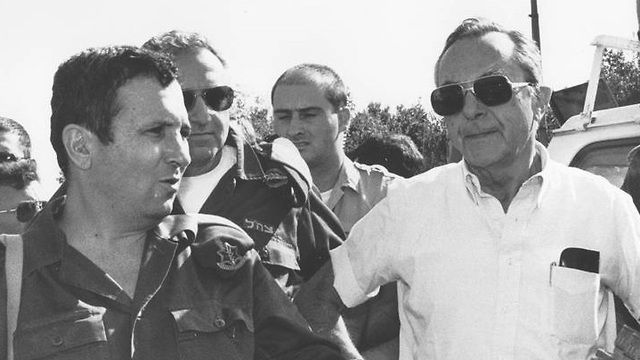
At 7:45am, the defense minister convened another meeting. The Air Force commander presented the plans for the intelligence sortie that very afternoon. He also presented three plans for special operations in western Iraq. "It turns out the Americans were unable in their first strike to destroy the entire Iraqi defense apparatus," said Ben-Nun. "Therefore I recommend taking a neighborhood in the city of Ramadi, which is west of Baghdad, and wiping it out with 80 tons of bombs." The Navy commander, Maj. Gen. Micha Ram, had another suggestion: "Let's sink four Iraqi merchant ships." The head of the IAF's Air Group, Brig. Gen. Amir Nachumi, said that "if Israel doesn't respond, the Iraqis will try to hit us with chemical warfare."
That day, at 3pm, it appeared that the coordination with the Americans was unsuccessful, and the intelligence sortie was postponed to the following day. That evening, the Americans informed Israel they were willing to immediately provide it with two Patriot batteries to brign down the Iraqi missiles. Major General Thomas R. Olsen, a representative of the United States Central Command (Centcom) landed in Israel the next day with satellite images of western Iraq, which was supposed to give the Israelis a sense of cooperation. But the photos were taken a month prior and not in real time. During Olsen's stay in Israel, four missiles were launched at the Dan region—further proof the American activity in western Iraq was ineffective.
Soon after the second missile launch, at 9am on January 19, the defense minister convened a meeting. He gave an update about his conversation with his American counterpart, then-defense secretary Dick Cheney, during which Arens raised Israel's request to take intelligence photos during the day and act in the evening. The Air Force commander once again presented a plan for an intelligence sortie in the afternoon, and again the Americans didn't cooperate, claiming they had no control over the Arab nations that the Israel Air Force would have to fly over on its way to Iraq. Arens, Shomron and Barak agreed that action must be taken so the Americans would have no choice but to agree—even if it entailed shooting down Arab planes on the way. Arens concluded the discussion, saying: "First western Iraq, then we'll go for Baghdad."
At 10am, the Air Force commander presented the IDF chief with his plans of action in western Iraq. Dan Shomron argued Israel had to "get a foot in the door." Meaning: Israel had to do something—be it an intelligence sortie or an attack, even a symbolic one—to try and deter the enemy.
At 10:45am, the IDF chief gave the Air Force commander the green light "to prepare for a violent intelligence sortie in western Iraq. If the planes identify a relevant target, like a Scud missile launcher, they are authorized to attack." At 11am, the defense minister approved the plan. At 2pm, the sortie was supposed to get underway.
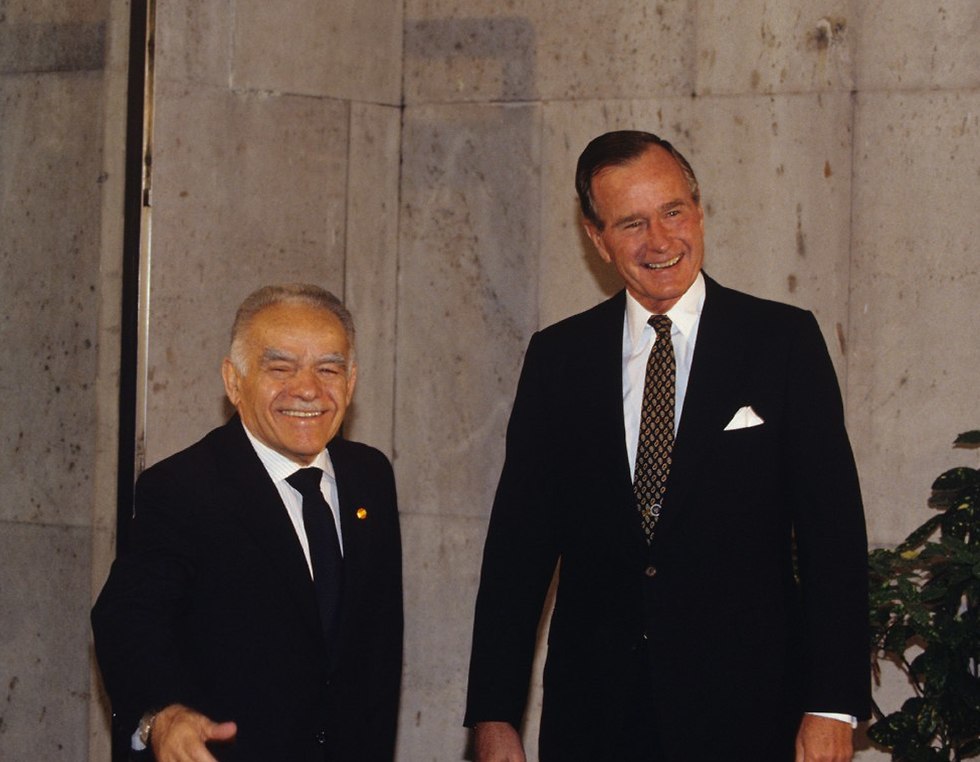
But then, at the very same forum that approved the plan, the defense officials started faltering. Arens received an update that then-prime minister Yitzhak Shamir had spoken to US President George H.W. Bush, who told him he had been unsuccessful in reaching understandings with Saudi Arabia and Jordan about Israeli operations in Iraq. At 12pm, the defense minister asked the IDF chief to change the flight path of the sortie. In light of the change, the IDF chief reached the conclusion the sortie could take place that day.
At 12:30pm, Arens convened another meeting. The Air Force commander informed the forum that the intelligence sortie would not be carried out that day. By this point, the enthusiasm among the senior ranks of the IDF for any kind of operation in Iraq had dropped. Everyone was talking about the possibility of an entanglement with Jordan, leading it to join the war.
At 4:30pm, Shamir ended the charade and gave the order: "Israel will not respond. We will discuss this again near the end of the war."
This dynamic of zig-zagging and quickly switching from enthusiasm to weariness, which in reality stemmed from a lack of preparedness, was present until the very end of the crisis. The military itself didn't understand what it wanted; it began with plans for small commando operations, moved on to extensive preparations to conquer western Iraq using hundreds of troops who would remain in the field for days on end, and ended with nothing.
The plan to hit Iraq's dams
The issue of punitive measures came up again in a situation assessment by the General Staff on January 21. All of the speakers pointed to the inability—both by Israel and the US—to eliminate the surface-to-surface missile threat on Israel, and recommended patiently monitoring further developments. Maj. Gen. Yoram "Yaya" Yair, who was the commander of the 91st "Galilee" Division, spoke about retaliatory and deterrence operations to stop the missile fire, and proposed a plan to destroy two dams on the Tigris River, which must have been a contingency plan. Destroying the dams would lead to extensive flooding and grave damages to populated areas in Iraq. But the Air Force commander had reservations due to operational limitations, and the proposal was scrapped.
As far as we know, this plan was first brought up in discussions held at the Defense Ministry even before the fighting began. On October 19, 1990, Arens requested an examination of the option of attacking dams on the Euphrates and Tigris rivers in Iraq. The Intelligence Directorate examined the ramifications of destroying two of the three dams: Haditha, Saddam (now known as the Mosul Dam), and Samarra. At the same time, the head of the IDF's history department, Col. (res.) Benny Michelson, was required to prepare a report on the ramifications of the British attack on the Ruhr valley dams in Germany in 1943.
The attack of the dams on the Tigris, which was rejected on January 21, 1991, was brought up again for discussion on February 10 by the head of the Operations Division. By that point, the Americans had already destroyed most of the relevant targets, and Israel had no choice but to settle for the dams as almost the last realistic option it had left to restore its deterrence. At the end of the discussion, it was decided that the MID would gather information about seven dams in Iraq, and the Air Force would present the head of the Operations Division with operational plans of attack by February 19—nine days later. These decisions were made despite the fact two and a half weeks earlier, the Air Force commander stated he did not have the ability to carry out these attacks.
The situation assessment was that despite the immense damage to both lives and property in Iraq, world opinion would have an easier time stomaching such an operation than a brutal bombardment of a city. But, as was the fate of all of the IDF's plans during the First Gulf War, the plans to attack the dams were not ready before the end of the conflict.
700 sorties a day
There was just one point at which Arens managed to seize the opportunity with his American counterpart. On January 22, at 8:30pm, a rocket landed on Abba Hillel Street in Ramat Gan, causing heavy damage and leading to the deaths of three elderly people through heart attacks. The defense minister and the IDF chief of staff visited the site, and left with a strong sense that the Americans' Patriot systems were incapable of properly intercepting the Iraqi Scuds. Israel had reached the limits of its patience – and of its restraint.
At 10:30pm, Arens convened a debate on how Israel should respond. "If the rocket launches do not stop," the defense minister told the generals, "our civilians will flee the urban areas." This grim prediction was to come true.
Arens spoke with Cheney during this debate, and for the first and only time, the Americans agreed to allow Israel to take action in western Iraq, west of a line that would be set between the two sides. However, the Americans repeatedly stressed that they were unable to arrange any Israeli coordination with the Jordanians and the Saudis, and that this was already Israel's business.
However, the Air Force meteorologists warned that bad weather was expected over Iraq for the coming two days, and there was also a dispute over the size and intensity of the operation. The head of the Israel Air Force was talking about 700 sorties a day, otherwise it would be impossible to complete the mission. Others proposed making do with targeted actions by IDF special forces. And again they went back to arguing who would be responsible for the operation – the commanders on the ground or the Air Force?
At a cabinet meeting held on January 23 at 9am, the prime minister realized what he was dealing with. In order to avoid offending the chief of staff and not back himself into a corner, the prime minister authorized ongoing preparations for a wide-ranging operation in western Iraq, but, in a hint to the army of his true plans, Shamir ordered additional plans to be drawn up. "Until then," he said, "there is no authorization for anything."
Israel never struck Iraq during the Gulf War, although it came close.
The Gulf War is a poor precedent. Today, as Aviv Kochavi prepares the army for the post-civil war era in Syria, he must take into account the fact that Israel will always be subject to political pressure from a power that would deny it freedom of action - whether it is the Americans in Iran or the Russians in Syria.
Another lesson from the Gulf War is that the IDF was unprepared for shifting regional threats. The plans were drafted during wartime, and even the army itself was not convinced that they could hold up. In order to withstand pressure the political echelon had to be sure that it had an army with true ability, or the diplomatic battle would also be lost.
The third lesson was one intended mainly for Israel's neighbors: In the Gulf War, Israel prepared especially harsh punitive measures. It did not implement them because it was not ready from a political, operational or intelligence standpoint. But its willingness to harm civilian populations in order to cause enormous damage to an enemy state, still exists today. The long-range intelligence and operational capabilities also exist. The enemy must know that the only thing that prevents Israel from striking major cities in response to attacks on its own civilians is the willingness of the political echelon to actually do it.














